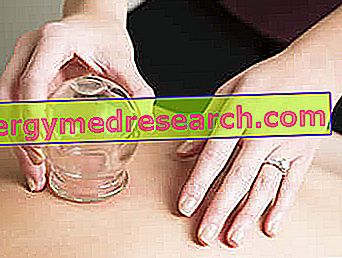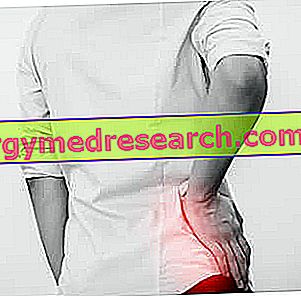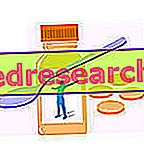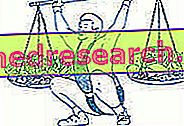Generality
Cupping is a therapeutic practice of alternative medicine, which involves the suction of some anatomical areas of the human body, using special jars, with the final intention of bringing benefits to the individual subjected to the treatment in question.

There are different types of cupping; the most common types are dry cupping, wet cupping and mobile cupping.
At the moment, no scientific study has shown that cupping has a real therapeutic effect. In other words, according to science, cupping would be completely ineffective.
What is cupping?
Cupping is a therapeutic practice of alternative medicine, which involves the suction (or aspiration) of some anatomical points of the human body; for this purpose, it exploits the application of special jars on the skin, with the final aim of promoting the health and well-being of the individual subjected to the treatment in question.
WHO CAN PRESS THE COUPLING?
The practice of cupping is only for persons qualified by a specific certification.
ORIGINS
According to some historical testimonies, the practice of cupping would have very ancient roots. The description of a similar technique would in fact appear in one of the oldest medical texts still present today, dating back to Ancient Egypt: the famous Papyrus of Ebers (1550 BC).
operation
According to those who practice cupping, the suction of a portion of the body would determine, at the level of the anatomical area concerned, a series of closely linked events:
- The first event is the release of soft tissues and connective tissues ;
- The second event is the increased flow of blood and lymph ;
- The third and final event is a more effective elimination of waste substances and toxins by the body's cells .
In other words, where it is applied, skin suction would promote blood and lymphatic circulation, thus encouraging the elimination of waste products and toxins from the body.
It is through the elimination of waste products and toxins that cupping brings well-being to patients.
CRITICAL AREAS FOR SESSION
In the theories of those who practice cupping, the sites of suction depend on the condition that the patient complains of and that the therapist wants to cure.
This means that, depending on the purpose of the cupping, the anatomical points on which the therapist applies the jars are different.
In reality, it is important to point out that the critical areas of application of the jars are limited and located in very precise points of the human body.
A certified therapist knows the critical areas and knows on which occasions to apply the jars.
Indications
According to its promoters and practitioners, cupping would benefit those who suffer from:
- Headache and migraine;
- Rheumatic diseases, such as rheumatoid arthritis or fibromyalgia;
- Hypertension;
- Sciatica;
- Intercostal neuralgia;
- Anxiety and depression;
- Bronchial asthma;
- Fertility disorders;
- Gynecological diseases;
- Varicose veins;
- Sense of fatigue and recurring fatigue;
- Neck pain;
- Back pain.
How to do it
First of all, those who seek cupping must undergo a thorough physical examination and a careful medical history at the specialist who will carry out the treatment. Physical examination and medical history represent two obligatory steps, as they allow the therapist to:
- Establish the patient's state of health;
- Understanding the reasons for which the patient wants to resort to cupping;
- Plan on which points of the human body it is best to apply the jars.
Once this preliminary phase has been completed, the actual treatment can begin.
In order for the jars to promote the flow of blood and lymph in the areas concerned, it is essential to create a vacuum inside . To obtain the vacuum inside the jars, there are two techniques:
- A first technique involves heating and then cooling the air contained in the inside of the jar . For air heating, the therapist uses potentially dangerous flammable substances (eg: alcohol). This is why this first technique is less and less in vogue.
- A second technique involves the use of a special mechanical pump . It is a safe technique, which guarantees excellent results.
The application time of the jars is variable and depends on the purpose of the cupping. In some cases it could only be 3 minutes; in other cases, however, it could even be 10-15 minutes.
TYPES OF COPPER CUP
There are different types of cupping. Among the various types of existing cupping, the three probably the most common are reported: dry cupping, wet cupping and mobile cupping .
- Wet cupping: on the occasion of this type of cupping, the therapist temporarily removes the jars for sucking and practices, in the cutaneous areas freed from the aforesaid jars, small incisions. Then, reapply the jars in the same skin areas and practice sucking again. Unlike the beginning, this time the suction involves a small leak of blood from the incisions (NB: it is from the leakage of blood from the incisions that the term "wet" originates).
At the end of the treatment, the therapist applies, on the incised areas, an ointment with antibiotic properties and a protective bandage, with the final aim of preventing episodes of infection.
For the creation of the vacuum inside the jars, both available techniques are indicated.
- Dry cupping: this type of cupping involves the creation of a low-pressure area at the level of the skin area, on which the therapist applies the jars.
Unlike wet cupping, it does not require any skin incision (this is why it is called "dry" or "dry").
For the creation of the vacuum inside the jars, both available techniques are indicated, even if there is a particular preference for the use of the mechanical pump.
- Mobile cupping: it is called mobile the cupping which involves the movement of the jars, during the course of the treatment. In order to perform this type of cupping, the therapist lubricates the skin beforehand with an oily solution, which allows the jars present on the surface of the body to slide.
For the creation of the vacuum inside the jars, both available techniques are indicated.
Each type of cupping has its own advantages and disadvantages (the so-called "pros" and "against").
The choice of the type of cupping adopted is up to the therapist and depends on what the patient's problems are and on the therapist's preferences.
INSTRUMENTATION: THE BATHS
The jars used for cupping can be made of glass, plastic, bamboo, terracotta or silicone.
The choice to use the jars of a certain material, rather than another, depends on the type of cupping to which the therapist uses.
The number of jars used during a session is generally between 3 and 5; rarely, more than 5 jars are used.
COPPETTAZIONE AND AGOPUNTURA
Cupping is often related to acupuncture, since, in this way, it seems to have a better therapeutic effect.
Acupuncture is a practice of alternative medicine that involves the insertion of small needles on specific areas of the human body, with the final intention of promoting the health and well-being of the individual subjected to the treatment in question.
Risks and complications
If practiced by qualified personnel, cupping is a very safe and low risk practice. In fact, only in rare circumstances it gives rise to side effects.
The possible side effects of cupping include:
- Hematoma;
- Burns (only if using the technique of heating and cooling the air inside the jars);
- Ache;
- Skin infections.
Contraindications
Cupping has several contraindications.
The experts, in fact, strongly advise against it in the event of:
- Heart failure;
- Kidney failure;
- Ascites due to cirrhosis of the liver or severe edema;
- Hemorrhagic diseases, such as haemophilia or allergic purpura;
- Dermatoses (eg: allergic dermatitis);
- Bone fractures (temporary contraindication);
- Sunburn (temporary contraindication);
- Healing skin wounds (temporary contraindication);
- Obesity;
- Excessive thinness;
- Severe psoriasis.
Criticisms
As of 2015, no scientific and clinical study has demonstrated the effective therapeutic efficacy of cupping. This explains why many doctors advise against this practice in the presence of health problems for which there are valid treatments of traditional medicine, and define it as a pseudoscience .
WHAT THE EXPERTS SAY?
In 2008, the British science divulger Simon Singh and the doctor Edzard Ernst collaborated in the drafting of a text, entitled " Needles, potions and massages ", in which they explicitly state that there is no scientific evidence in favor of the therapeutic power of cupping, against any health condition (NB: the original title of "Needles, potions and massages" is " Trick and Treatment ")
We also report a recent statement by the American Cancer Society, in which the latter states that there is no convincing scientific evidence to support the possible anti-tumor power of cupping; on the contrary, it points out that the practice of cupping entails a considerable risk of burns for the patient.



